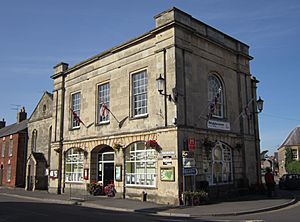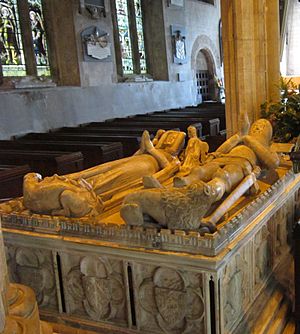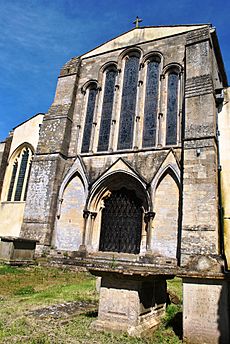Berkeley, Gloucestershire facts for kids
Quick facts for kids Berkeley |
|
|---|---|
 Berkeley Town Hall |
|
| Population | 2,252 (2021 Census) |
| OS grid reference | ST684992 |
| • London | 120 mi (190 km) E |
| Civil parish |
|
| District |
|
| Shire county | |
| Region | |
| Country | England |
| Sovereign state | United Kingdom |
| Post town | BERKELEY |
| Postcode district | GL13 |
| Dialling code | 01453 |
| Police | Gloucestershire |
| Fire | Gloucestershire |
| Ambulance | Great Western |
| EU Parliament | South West England |
| UK Parliament |
|
Berkeley (pronounced BARK-lee) is a historic town in Gloucestershire, England. It sits in the beautiful Vale of Berkeley, close to the River Severn. The town is famous for Berkeley Castle, a very old castle where some important history happened. It's also known as the birthplace of Edward Jenner, a doctor who created the world's first vaccine for smallpox.
Contents
Where is Berkeley Located?
Berkeley is found between the cities of Bristol and Gloucester. It's built on a small hill in an area called the Vale of Berkeley. The town is also on the Little Avon River, which flows into the larger River Severn.
A Look Back at Berkeley's History
Berkeley was first mentioned in records way back in 824. Its name, Berclea, comes from an old English phrase meaning "birch lea," which means a meadow with birch trees.
In the Middle Ages, Berkeley was a very important place. It was a port where ships could dock and a busy market town. Archeologists have found signs of a large minster (a type of church) and a monastery (a place where monks or nuns lived) near Berkeley Castle. These buildings were likely destroyed around the year 1044.
After the Normans took over England in 1066, a noble named Roger de Tosny was put in charge of Berkeley. His family later took the name "de Berkeley." Roger started building Berkeley Castle, which his son, also named Roger, finished. This family became very important in the area.
The town hall in Berkeley was built in 1824.
Berkeley's Nuclear Past
Berkeley was once home to the Berkeley nuclear power station. This was one of the very first commercial nuclear power plants in Britain. It had two large nuclear reactors. The power station has now been taken apart, and only the concrete buildings that held the reactors remain. A technical college called SGS Berkeley Green UTC has opened nearby, offering courses in engineering and cyber security.
The Legend of the Witch of Berkeley
There's an old local story about a "Witch of Berkeley." The legend says she sold her soul to the Devil for riches. Even though she tried to hide in the church, the Devil supposedly carried her away on a black horse covered in spikes!
Getting Around Berkeley
The Gloucester and Sharpness Canal starts close to Berkeley. This canal was originally known as the Gloucester and Berkeley canal.
Buses also run to and from the town, connecting it to other places.
Berkeley used to have its own train station from 1876 to 1964. The train line even went across the Severn Railway Bridge to Lydney. However, the bridge was badly damaged by a ship in 1960 and couldn't be used anymore. Some of the old railway line is still used today to move nuclear waste from the power station. A group is working to bring part of the line back for passenger trains. The closest train station now is Cam and Dursley, about 5 miles away.
Education in Berkeley
Berkeley has a small primary school for younger children. The town's secondary school, the Vale of Berkeley College, closed in 2011.
However, since 2017, SGS Berkeley Green UTC has opened near the old nuclear power station site. This is a special college that focuses on teaching students about engineering and cyber security.
Famous People from Berkeley
One of the most famous people from Berkeley is Edward Jenner, who was born here. He was a doctor who discovered vaccination. After studying medicine, he came back to Berkeley to work as the local doctor. In 1796, he noticed that milkmaids who got cowpox didn't catch smallpox. He then did a groundbreaking experiment: he gave a young boy named James Phipps cowpox, and then later tried to give him smallpox, but the boy didn't get sick! This showed that cowpox could protect people from smallpox.
Jenner is buried in the family tomb at St Mary's Church in Berkeley, and James Phipps is also buried there. Jenner's home in Berkeley, called The Chantry, is now a museum. He used to give vaccinations to local people for free in a small hut in his garden, which he called the "Temple of Vaccinia." This hut is seen as the "birth-place of public health" because of his important work.
Another notable person born here was John Fitzhardinge Paul Butler, who received the Victoria Cross, a very brave award.
See also
 In Spanish: Berkeley (Gloucestershire) para niños
In Spanish: Berkeley (Gloucestershire) para niños





